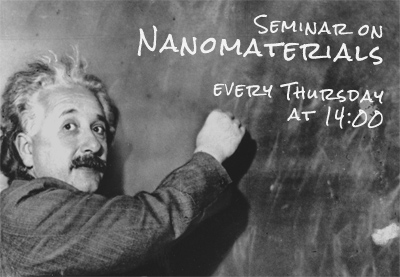Nanoseminar
Group of Structure analysis at the Department of Condensed Matter Physics
of Charles University and MGML has a pleasure to invite you to attend the seminar on nanomaterials: Physics, Technology, Applications
on 5th December 2024 at 14:00
at Faculty of Mathematics and Physics of Charles University, Ke Karlovu 5, 121 16 Praha 2
Lecture room F2
Vojtěch Chlan
Department of Low Temperature Physics, Faculty of Mathematics and Physics, Charles University
NMR Spectroscopy in Condensed Matter
Vojtěch Chlan » NMR Spectroscopy in Condensed Matter
Department of Low Temperature Physics, Faculty of Mathematics and Physics, Charles University
*corresponding author: e-mail: chlan@mbox.troja.mff.cuni.cz
Location: Lecture room F2, first floor Ke Karlovu 5, Prague 2
Nuclear magnetic resonance (NMR) spectroscopy is a versatile method for obtaining chemical, physical, and structural information about local properties of matter. In chemistry and biochemistry the method provides detailed and quantitative information on the structure and dynamics of organic compounds. For solids the NMR spectroscopy offers insights into the atomic and crystal structure, allowing to study local crystalline environment, defects and phase transitions, dynamics, or even magnetism.
In the talk I will show a few examples how NMR spectroscopy can be utilized for studying various condensed matter systems. High resolution can be achieved in solids by applying magic angle spinning (MAS) and this technique was applied to 27Al and 139La NMR in La1- xCexAlO3 crystals. Peaks from different Ce–O–La pathways can be resolved in 139La NMR spectra, while the behavior of 27Al spectrum is rather related to the change of the crystal structure in the vicinity of Ce ions.
Behavior of individual molecules of normal and heavy water in beryl single crystals was studied by 1H and 2H NMR spectroscopy. From temperature dependences of the spectra our analysis shows that the molecules perform rapid vibrations and orientational jumps within the beryl voids. We suggest that this is due to the molecules attaching to the oxygen atoms forming the beryl structural voids by a hydrogen bond.
55Mn NMR experiment allowed to observe and, in combination with DFT calculations, to identify fine details of the structure of Ni2MnGa Heusler alloy. Splitting of spectral lines is connected with modulation of the Martensite structure and additional lines appearing in the spectrum are induced by Mn-Ga anti-site defects.


